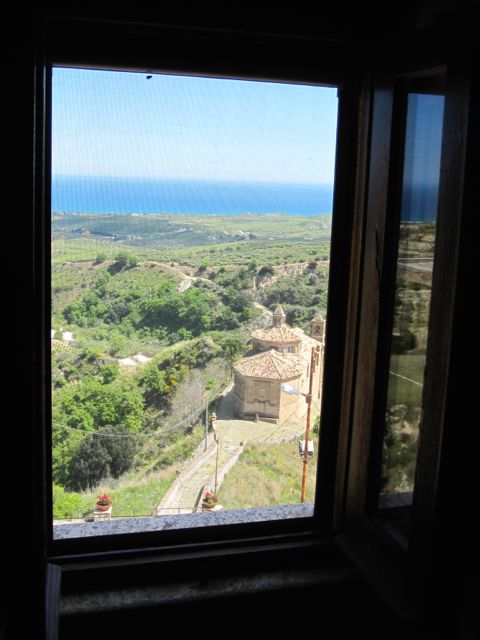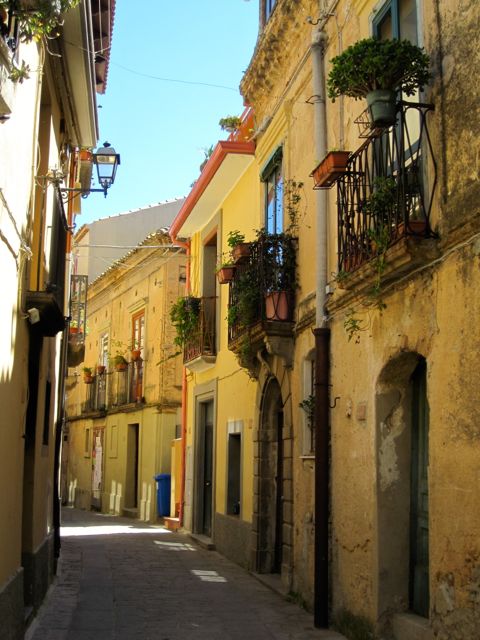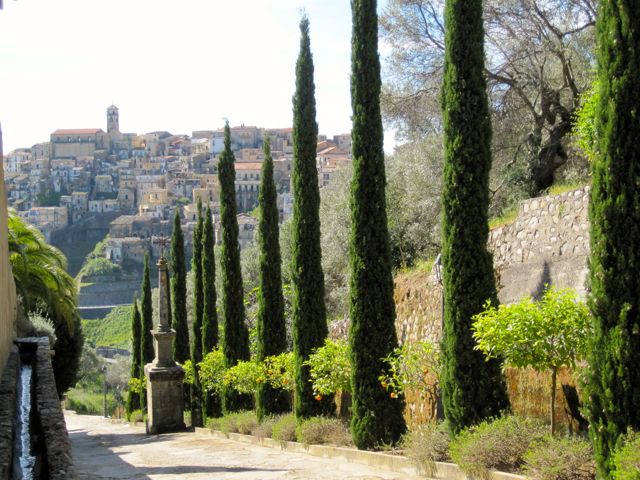As we drove up the hill to Badolato, a fleet of bicycles was coming down. The riders looked serious and there seemed to be a lot of them for a weekday morning in spring. “They’re Danish. We have a large Scandinavian community here in Badolato.” Having heard of the town’s welcoming of migrants some twenty years previously, I had expected a different sort of foreigner in Badolato. I quickly learned that this medieval village was a melting pot, a harmonious mix of native Badolatesi, migrants, emigrants and vacationers.
WHERE IS BADOLATO?

View of Ionian Sea from Badolato
The medieval town of Badolato lies in the sole of Italy’s boot about 30 kilometers (19 miles) south of Catanzaro, Calabria’s capital. The village sits on a hill at 240 meters (787 feet) above sea level and about five kilometers (3 miles) from the Ionian Sea. What this means is that the Badolatesi (people from Badolato) have wonderful views of a rugged, natural countryside meeting a clear blue sea.
The aforementioned Danes chose a location nearer the sea for their complex of 100 villette (small houses), easily cycling up to the old town past the large stone fortification walls to soak in a bit of village life when it strikes their fancy. Before the last century, the entire population was concentrated in the old town, which has weathered numerous earthquakes throughout its 1,000-year history.
The earthquake of 1947 followed up by a catastrophic deluge in 1951 dealt the definitive blows and the Italian state began to build homes near the train station along the coast. Thus, Badolato Marina was born, and Badolato proper began to empty out.
VILLAGE FOR SALE
In 1986, with much of the village abandoned, Badolato launched an initiative to sell vacated property in order to bring life back to the community. A novelty at the time, this paese in vendita or “village for sale” was first announced in Rome’s daily paper Il Tempo and quickly became popular with press all over the world. Other villages in distress followed suit.
The word was out and over thirty years later Badolato exhibits very positive results. Much of the village is inhabited, and there’s a distinctive bustle of activity, Italian style – in other words, a relaxed, convivial atmosphere.

Badolato Old Town
MIGRANTS IN ITALY
The initiative to repopulate the abandoned town through the sale of real estate would have been enough for such a small community to brag about; however, a decade later Badolato was also on the forefront of the migrant issue years before it became a common talking point. In 1997, the Badolatesi distinguished themselves by opening up their village to refugees crammed into a Turkish boat that happened to float up to their particular stretch of the Ionian coastline.
The political refugees were mostly Kurds of whom Badolato hosted 339, many in houses opened up by the municipality and others in private dwellings. Thus, the medieval village was once again thrust into the national, and then the international, limelight. The neighboring town of Riace (of the famous Riace Bronzes, life-sized ancient statues found in local waters) took up the cause shortly thereafter.
These early gestures of welcoming migrants in Calabria became the subject of Il Volo (2009), a short film shot in Badolato, Riace and Scilla by the German director Wim Wenders, best known for the award-winning documentary Buena Vista Social Club. Interestingly, at a 20-year celebration of the fall of the Berlin wall held in Germany’s capital city, Wenders reflected on his experience in Calabria: “The real miracle isn’t here, but in Calabria, where for the first time I saw a better world. I saw a community that, through its generous reception of outsiders was capable of resolving, not so much the migrant problem, but its own challenges regarding its future existence, so as not to die by way of depopulation and immigration.” (altralocride.it)
MONDO X
Another intriguing dimension to the town is the presence of a community called Mondo X, a national organization that helps people in difficulty, many of whom have struggled with drug addiction. They commit themselves to work and prayer, supporting one another in their isolated world without modern electronics or connection with the outside.
In Badolato, the group is all male, and their home is a former Franciscan monastery that they themselves have fixed up. This 17th-century complex sits on a hill facing the town with a beautiful view down its cypress-lined drive and up to the old town. The members work many hours in their large garden, and when needed, help out with projects in the village.

Badolato as seen from St. Mary of the Angels, former Franciscan Monastery, home to Mondo X
THE MULTICULTURAL COMMUNITY
At this point, the reader is no doubt asking himself just how this all comes out in the wash. And I’m going to be honest, when I first saw the cyclists and started running into people from different parts of the world in the old town with a population of just several hundred during most of the year, I was skeptical.
Let’s face it, most people go to Italy to experience the Italian culture, eat Italian food, meet Italian people, and so forth. Of course, I remind myself that the length of the Italian boot has been dominated and influenced by a myriad of cultures throughout its existence.
What first convinced me that it all worked was my observation of the older people, the sparkle in their eyes, the life in their faces, their enthusiastic “buongiorno,” and the active participation and interaction between the local seniors and the non-Italian residents and tourists. Moreover, these foreigners were happy to be there and that pleasant feeling seemed to spread.
So what about the migrants? At one point as our little group was walking through the narrow lanes with our host Guerino Nistico’, a little girl came running down the street, called out with a long “Ciao,” and jumped into his arms. He swept her up with a, “Ciao, bella!” And she started chatting away in perfect Italian. Her grandfather, one of the original Kurds, stepped out of his doorway and waved to Guerino. He had chosen to stay and put down roots in the community. The headwaiter at the pizza place on the main square was from Pakistan, and he wasn’t going anywhere else anytime soon, either. Of course, for many other migrants, Badolato was and is just a stepping stone.
BADOLATO HOSPITALITY

Badolato interiors
As a visitor, I literally got a taste of the local hospitality when going around the old town and meeting a few of the village’s newer residents living in beautifully renovated homes. They were eager to show what they had done with the interiors, but as beautifully designed and executed as they were, the incredible views from the rooms and expansive terraces were difficult to top.
Characteristic elements such as huge, exposed ceiling beams, wood-framed windows, stone walls and old floor tiles blended with both rustic and modern furnishings. Original, uneven stone staircases and sleek, metal steps served to connect the rooms of the multi-storied dwellings.

Architectural elements in Badolato interiors
Many interior spaces embraced new functions, such as a former donkey stall that was transformed into a comfortable, eat-in kitchen. Terrace tables were filled with pitchers of fresh-squeezed lemonade, cocktails, wine and an assortment of savory treats.

Badolato refreshments
The newer Badolatesi weren’t only from northern Europe and politically challenged countries, there were also Italians from other regions as well as several Americans. Many were vacationers or retirees, while others plied a trade in the old town. I had the opportunity to meet a few writers, a chef and even a yoga instructor.
MY STAY IN BADOLATO

A narrow, hilly lane in Badolato
My narrow, multi-storied lodging placed me in the heart of the medieval village. The steep, narrow streets fostered a construction in which each floor was a room, and there was an entrance on each level. The main door led into the kitchen on the top floor, the middle story had a door onto the side street, and the bottom level’s doorway faced the lower street to the back. Inside, a modern, metal staircase led from the kitchen down to the two bedrooms and baths below. Cozy, and it gave me the feeling of what a small home in the village was like.

Apartment in Albergo Diffuso of Badolato
Visitors have a choice of various apartments and rooms in what is referred to as an albergo diffuso, which means a hotel or accommodations spread out in various locations or buildings throughout the old town. And for a relaxing vacation, a peaceful view of rolling hills and a chorus of birds cannot be underestimated.
However, for me, it was the enthusiasm of the people that won out – the welcoming atmosphere; the Badolatesi, emigrants and migrants gave off an air of contentedness. And this ambience is the sort that vacationers pick up on, and some even cycle around the countryside with it.
UPDATE: Badolato is now one of the Borghi più belli d’Italia – Italy’s Most Beautiful Villages!
Thanks to Riviera e Borghi degli Angeli of Badolato for inviting me to Badolato and sharing the village’s story and hospitality with me. The association is a network of local individuals and businesses with the mission to promote the area for the betterment of Badolato, its residents, guests and the territory.
 Read more about the region’s many other villages, towns and cities in Calabria: The Other Italy, my non-fiction book about daily life, history, culture, art, food and society in this fascinating southern Italian region. Check out a few other blog posts about Calabrian localities: Pentedattilo: A Ghost Town in Calabria, Amantea: A Seaside Attraction, Palizzi: Yesterday and Today, San Giovanni in Fiore: Gioacchino’s Outpost in the Sila Mountains and Cosenza: Old and New.
Read more about the region’s many other villages, towns and cities in Calabria: The Other Italy, my non-fiction book about daily life, history, culture, art, food and society in this fascinating southern Italian region. Check out a few other blog posts about Calabrian localities: Pentedattilo: A Ghost Town in Calabria, Amantea: A Seaside Attraction, Palizzi: Yesterday and Today, San Giovanni in Fiore: Gioacchino’s Outpost in the Sila Mountains and Cosenza: Old and New.
“Like” Calabria: The Other Italy’s Facebook page for more beautiful pictures and information.
Sign up below to receive the next blog post directly to your email.
CALABRIA: THE OTHER ITALY makes a great gift!
Check out the itineraries of my Calabria tours!

Comments 21
Thank you for a lovely view of Badolato.
Author
Glad you liked it, Julia. I had a very, very nice time there.
This town, with its vibrancy, scenery, culture & history, seem like a WONDERFUL area to visit! Its “distinctive bustle of activity … Italian style”, seems to make it irresistible!!!!
Thanks for all this fascinating information!
Author
Glad you enjoyed it!
Lovely tour of Badolato. Have you met Michelle Fabio from Bleeding Espresso? She lives in Badolato and frequently posts beautiful photos of the views. I love the views where you can see the Ionian! Ciao, Cristina
Author
Thanks. I know Michelle through her blog, but unfortunately when I was there, she was sick, so we didn’t get to meet in person. Next time!
New perspectives and the mixing of cultures makes for much more interesting destinations. It’s wonderful that Badolato has embraced this.
Author
Yes, the town is an excellent example of successful multiculturalism.
As I had emailed you previously, I stayed in Badolato which was very close to Isca where my maternal grandparents families were from. The hospitality was amazing.
Author
I agree, the Badolatesi are so welcoming to guests. They offer visitors an excellent cultural immersion experience and they go the extra mile to show them a good time.
Reggio is the capital of Calabria. Not Catanzaro.
Author
While many people still think Reggio is the capital of Calabria and it is certainly the largest city in Calabria, Catanzaro is currently the capital of the entire region. I discuss this in my book Calabria: The Other Italy.
Glad you got to go to Badolato. We are lucky enough to live only two towns north, in the summer, so we visit there regularly. I call it “The Greenwich Village” of Catanzaro province.
Author
Great characterization of the town as there’s such an active arts scene in the summer. Badolato is an excellent example of a village taking control of its destiny. They’ve worked together to overcome difficulties and in the process have created a unique atmosphere that has enhanced the quality of life for the locals and attracts visitors, talented guests and interesting new residents who in turn enrich the community.
CONSIDERING VISITING
Thank you- loved reading this. I was one of 339 Kurdish refugees who arrived there with my parents; I was only 3 at the time! The journey there was dangerous as the boat was unsurprisingly very old and not really designed to carry that many people. The day we arrived at the dock, although I don’t remember, my parents say that the locals were already waiting, eager to welcome us. We stayed there for just under a year – loved it. I vaguely remember our neighbour always bringing us eggs and other groceries for breakfast, bless her. We then migrated to the U.K. mainly because we already had close family here. Sometimes I wonder how life would’ve turned out if we stayed!
Author
Wow – thank you so much for your testimony of this perilous journey followed by the incredible welcome you and your family received by the local people. It’s great to read such positive memories of your time in Calabria and that you successfully moved on to your final destination and new life. Have you ever been back to visit? Thanks again for your comment, which helps make an historic moment in time feel more real for those who haven’t experienced it.
Wow. Calabria never ceases to amaze! Never heard of Badolato – thank you –
Family from Pizzo –
Thank you Karen!
Author
You could spend a lifetime exploring Calabria, from the mountains to the sea, the 404 communities and all of their neighborhoods! Having become part of the “Most Beautiful Villages in Italy,” Badolato will continue to garner attention, as has the entire region over the past few years.
What is Badolato like in November?
Author
The weather is usually pleasant along the Ionian coast in November.